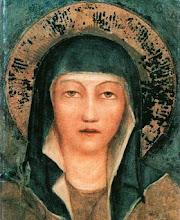I hope that everyone had a WONDERFUL St. Francis Day!
Many thanks to one of my friends who sent me the link to the following article. It perfectly elaborates on the relationship between St. Clare and St. Francis. As one correction to the article, I don't think that the film Brother Sun, Sister Moon depicts the Saints' relationship as romantic at all. But let the article speak for itself!
ROME, OCT. 4, 2007 (Zenit.org).- Here is the text of a commentary written by Capuchin Father Raniero Cantalamessa, preacher of the Pontifical Household, on the relationship between Sts. Francis and Clare.* * * It has become commonplace to speak of the friendship between Clare and Francis in terms of falling in love. In his essay "Falling in Love and Loving," the sociologist F. Alberoni says that "the relationship between St. Clare and St. Francis has all the characteristics of falling in love, sublimated or transferred to the Godhead."Francis, like any man even if he is a saint, may well have experienced the attraction of woman and the call of sex. The sources tell us that in order to overcome a temptation of this kind the saint once rolled around in the snow in the depths of winter.But it was not Clare who was the object of the temptation!
When a man and woman are united in God, this bond, if it is authentic, excludes all attraction of an erotic kind, without even a struggle. He or she is, as it were, sheltered. It is another kind of relationship. Between Clare and Francis there was certainly a very strong human bond, but it was paternal or fraternal in kind, not spousal. They were like two trees joined by their foliage, not by their roots.
The extraordinarily profound understanding between Francis and Clare, which features so strongly in the Franciscan epic, does not come from "flesh and blood," like that between Eloise and Abelard, or Dante and Beatrice (to quote two equally famous examples). If it had done so, it might have left some trace in the literature, but not in the history of sanctity. In one of Goethe's well-known expressions, we could call the friendship of Francis and Clare an "elective affinity," as long as we understand "elective" not only in the sense of people who have chosen each other, but who have made the same choice.Antoine de Saint-Exupéry wrote that "being in love does not mean looking at each other, but looking together in the same direction."
Clare and Francis really didn't spend their whole lives gazing at each other and feeling good together. They exchanged the fewest of words, probably only those reported in the sources. There was a tremendous reserve between them, so much so that at times the saint was affectionately chided by his brothers for being too harsh with Clare.
Only at the end of his life do we see this rigor in the relationship soften, and Francis visits his "little plant" more and more frequently in search of comfort and confirmation. As death draws near and sickness consumes him, San Damiano becomes his refuge, and it is at her side that he intones the Canticle of Brother Son and Sister Moon, with its praise of "Sister Water," "useful, humble, precious and chaste," which might have been written with Clare in mind.
Instead of looking at each other, Clare and Francis looked in the same direction, and we know what "direction" that was in their case. Clare and Francis were like two eyes always looking in the same direction. Two eyes are not just two eyes, I mean, not just one eye repeated. Neither of the two eyes is just an extra or a spare eye. Two eyes looking at an object from different angles give depth and relief to the object, enabling us to enfold it in our gaze. That is how it was for Clare and Francis.They looked at the same God, the same Lord Jesus, the same crucified one, the same Eucharist, but from different "angles," each with their own gifts and the sensitivity proper to a man and a woman: masculine and feminine. Together, they understood more than two Francises or two Clares could have done.
Recently, a good television film was made, called "Francis and Clare," produced by Fabrizio Costa. It will run on Channel 1 of Italian Television (RAI Uno) on Oct. 6 and 7, and will soon be seen on English-language television, as it was originally shot in English. Better than Franco Zeffirelli's "Brother Sun and Sister Moon," it manages to avoid the romantic charm of a human love story.
In the past there was often a tendency to present the personality of Clare as too subordinate to that of Francis, exactly like a "sister Moon" who lives in the reflected light of "brother Sun." The latest example of this is John M. Sweeney's study "Light in the Dark Age: the Friendship of Francis and Clare of Assisi."All the more praiseworthy, then, the fact that the authors of this television fiction have chosen to present Francis and Clare as two parallel lives, interweaving and unfolding synchronically, with equal space given to the one and the other. This has never been done in this form before, and it echoes the sensitivities of today and contemporary efforts to highlight the important presence of women in history. But in this case, it is not a matter of ideological spin, but a portrayal of reality.
Watching the preview of the film "Francis and Clare," what struck me most was the symbolic opening scene. Francis is walking through a meadow and Clare follows him, almost playfully putting her feet in the footsteps left by Francis. He, asks her: "Are you following in my footsteps?" She replies brightly: "No, much deeper ones."




0 Comments:
Post a Comment
<< Home